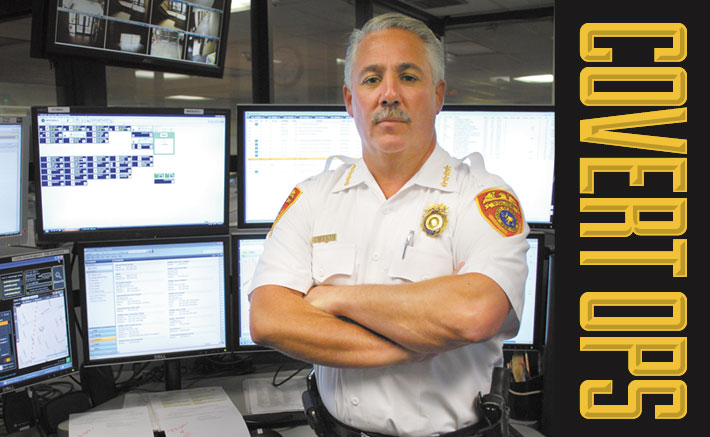
School’s Out
This former elementary school in Massapequa offers no escape from the oppressively hot and humid summer day. It is eerily quiet inside; no signs of the children who once roamed its long, hollow-sounding hallways. No slamming of lockers. No vibrant young voices as they shuffle to and fro class. They’ve been replaced with a new kind of teacher and a new challenge.
The building is locked, and admittance is only granted through a telephone located at the side of the large entrance doors. Once inside the lobby there are a few clues to the new tenants—an antique police car and a uniformed guard. At the far end of a long hallway are double-glass doors covered with the Nassau police insignia.
The air is cooler, the people busy with purpose. One room is filled with computers shadowed by television monitors tuned to the major networks. Another houses a large video screen, computer components and a conference table. One room remains a classroom. In the hallway a large screen displays current information on wanted criminals and news of those that have been apprehended.
Ryder, as head of this team, is anxious to explain what is happening here. He’s dedicated the past few years of his life to building it, even going back to school to get his master’s degree for the position. While he spent the beginning of his career on the streets, Ryder now looks like any college professor. He dresses casually, and speaks with an enthusiasm that could rival a new mother. And, in many ways, intelligence-lead policing is Ryder’s baby.
The unit, as many other intelligence contingents across the country, traces its roots to the Sept. 11, 2001 attacks. In Nassau, terrorist Intel was expanded to include local crimes.
Nassau County’s first established their Intel Center in January 2002. It began with two detectives working five days a week. It has since expanded to nine detectives, four civilian analysts and an additional detective sergeant, according to Ryder, who explains that the center is manned seven days a week and the staff can access the data from their home computers if necessary.
“We need to get as much info gathered and centralized in Intel,” he explains. “Every arrest in this county gets debriefed [in which detectives question suspects not only about the crime allegedly committed, but about accomplices or other related crimes in that area]. The villages have come onboard, too. That information gets sent to the center. So when I get the form that says this guy is a bad guy and may have a gun, I want to share that with everybody. So I bring it in, vet it out through the process and pump it back out.”
In addition to access to the 118 red light cameras covering 50 intersections throughout the county, which run streaming video that is saved for 30 days, Nassau’s police department has their own cameras, along with mobile and stationary license plate readers. ShotSpotter was installed in July 2009 and the use of license plate readers was expanded for data analyses capabilities in 2008.
Ryder believes the computer database program Nassau utilizes, Intel Tracker, is one of its greatest assets, because it “allows us to cross-reference cases in the county to make us more productive, stop repetitive work and create a safe environment for the cops during the investigation.”
As with most communities across America with a high crime problem, LI residents in troubled neighborhoods are also afraid to call the police, he says, fearing that if they identify lawbreakers and the word gets out, they may be targeted.
Ryder says his work addresses that problem.
“Because of [intelligence-led policing technologies], now the community does not have to get involved,” he says. “We are better at protecting them. We are saving lives and locking up bad guys and better protecting the community because technology will do the work that you can’t do because of retaliation.”
The detective lieutenant’s assurances come during a time of increased gun ownership in Nassau and Suffolk.
In Nassau, the number of new licenses more than doubled between 2008 and 2011, going from 659 in 2008 to a high of 1,420 in 2011, according to police records. Renewals also increased during that time, going from 4,552 in 2008, to a high of 5,539 in 2011. While target licenses are the easiest and usually most common people can get, from April through December 2011, Nassau issued only 154 target and 267 full-carry permits. For the first four months of 2012, they issued 206 targets and 187 full-carries. Suffolk was unable to provide these statistics.
In Suffolk, new permits show a continual increase, from 1,127 in 2008 to 1,350 in 2011. Renewals rose from 5,196 in 2008 to a high of 7,386 in 2011.
License plate readers have also become a mainstay for police intelligence. Nassau County has at least one in every precinct, as well as in unmarked cars, in traffic cones, on car bumpers, in landscaping trailers and on poles, both overtly and covertly.
Ryder uses North New Hyde Park as an example of its effectiveness.
Residents were up in arms over a rash of burglaries, he says. They demanded help. They wanted the police to do something and they wanted results.
The police put three license plate readers in the neighborhood, he tells the Press. Over a period of 30 days they obtained the numbers on 20,000 license plates.
Now they just had to find the one that was used in the burglaries.
The crime pattern had been limited to Friday and Saturday night between 6 and 10 p.m. All reports not in that time period were filtered out, leaving 10,000 plates. Those were filtered out to only dates burglaries occurred. That brought the number down to 2,000. Those plates were run, and anyone who lived in the neighborhood was also eliminated.
The list then came down to four cars. The plate numbers on those vehicles were shared with all surrounding law enforcement agencies, and three days later Floral Park Police stopped one of the cars with four men in it.
An occupant in the back seat had just sold proceeds from a burglary committed the day before.
“We arrested all four. They went for about 10 of the burglaries. My burglary problem went away,” smiles Ryder.
Suffolk has also been utilizing Intelligence-led policing.




